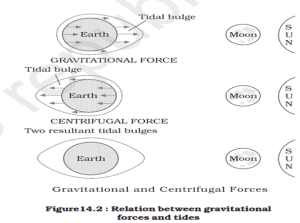Ans.
APPROACHIntroduction- Describe the movements of water in the ocean and briefly mention the forces responsible for such movements. The Body
Conclusion- Highlight briefly the positive and negative impacts of such ocean water movements. Mention the need for constant monitoring of these movements. |
Introduction- The ocean water is dynamic as manifested in the ocean water movements, which occur due to various factors. The physical characteristics of water, such as temperature, salinity, and density and external forces, like the influence of the moon, sun and winds, play a vital role in generating horizontal and vertical movements of water.
The Body
Types of ocean water movements:

1. Waves: It involves the movement of the energy (and not the water) across the surface of oceans. Water does not move in waves, but the wave trains move ahead. Ocean waves are, thus, the oscillatory movements that cause the rise and fall of ocean surface waters. The actual motion of water beneath the waves is circular.
Steep waves are fairly young, while steady and slow waves are considered to have originated from faraway places. Thus, the wave’s size and shape provide lots of insights into its origin.

Forces responsible: Winds are the driving force for the origin and development of waves in oceans. The dissipation of the waves occurs on reaching the shorelines where the friction between dynamic water and sea floor increases and eventually slows down the waves.
While winds push the water body in its course, gravity tends to pull the crests of waves downwards. Thus, waves are characterized by troughs and crests.
2. Ocean currents: Akin to rivers flowing in oceans, the ocean currents are continuously flowing huge amounts of water in a definite direction. The ocean currents may be classified based on their depth as surface currents (upper 400 m of the ocean) and deep-water currents (90% of the ocean water). Based on temperature, ocean currents may be warm or cold currents. Examples of warm currents include Agulhas, Gulf Stream etc.
Examples of cold currents include Oyashio, Falkland currents etc.
Forces Responsible:
Primary forces
(Initiate the movement of ocean currents)
- Insolation- Heating by solar energy causes the expansion of water and leads to a slight gradient between waters near the equator and mid-latitudes.
- Winds- Winds blowing over the ocean water surface push the water to move. The friction between the winds and surface water affects the velocity of ocean currents and their movement.
- Gravity- It pulls down the water that is piled up and, as a result, creates a gradient variation.
- Coriolis force- The rotation of the earth responsible for Coriolis force deflects the ocean currents to move clockwise(rightward) in Northern Hemisphere. The currents of the Southern Hemisphere are deflected to the left.
Secondary forces
(Influence the direction and flow of currents)
- Density variations: The vertical mobility of water is affected due to differences in density of water.
- Cold water and more saline waters, on account of being denser, tend to sink. On the other hand, relatively warm and less saline water tends to rise.
- Coastline: The shape and configuration of the coastline affect the direction and movement of ocean currents. E.g., Monsoon currents
- Bottom relief of oceans: The submarine ridges and canyons usually alter the direction of ocean currents. E.g., The North Atlantic Drift is deflected rightwards on crossing over the Wyville-Thomas ridge.
3. Tides: Tides refer to the periodic rise and fall of the sea level once or twice a day. Tides are commonly witnessed along the Gulf of Khambat, Bay of Fundy (Canada) etc.
Forces responsible: Tides are generated under the influence of the gravitational attraction of the sun and moon.
Centrifugal force is another tide-influencing force. It counteracts to balance the gravity. Altogether, the gravitational pull and centrifugal force create two major tidal bulges in the earth.
When the surface of the earth is nearest to the moon, the gravitational attraction of the moon exceeds the centrifugal force, thus causing a bulge towards the moon. On the opposite side of the earth, where the influence of the moon’s gravitational force is less, the centrifugal force dominates, creating a second bulge away from the moon.

Conclusion:
The movement of ocean water carries immense energy, which can be harnessed for the production of electricity and salt manufacturing. The ocean currents not only affect the micro-climate of the regions but also play a crucial role in navigation and harbours. On the other hand, waves and tides can prove devastating when the levels of seawater breach safe levels and result in tsunamis, storm surges and coastal inundation. Therefore, monitoring the movement of ocean waters becomes crucial.
Additional Information
· Spring tides: Such tides have their height higher than the normal tides since the sun, moon and the earth are aligned in straight line. The spring tides occur twice a month – during the period of full moon and new moon.
· Neap tides: Following a seven days gap after spring tides, usually neap tides are a natural phenomenon. During this time, the sun and moon are aligned at perpendicular positions with respect to each other. Consequently, the gravitational attraction of the moon and the sun counteract one another, leading to neap tides, which have heights lesser than that of normal tides.
Ocean Currents:


